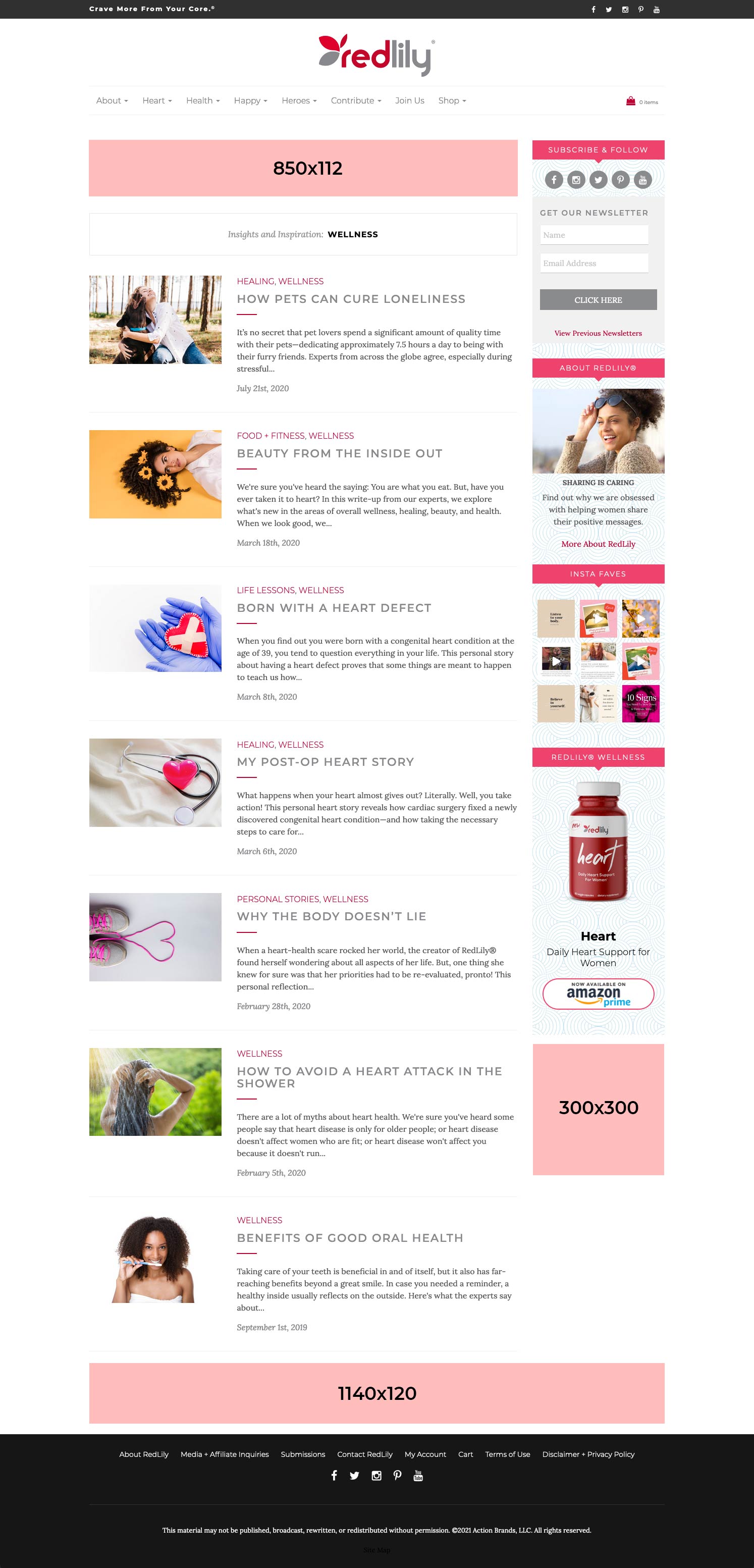As a follow up to our article on why holistic and preventative measures are important to your overall wellness, here’s a step-by-step guide on how to achieve optimal health for the woman trying to balance it all. Life is super busy—and we want to help.
Editor’s Note: This post is dedicated to re-affirming the importance of optimal health, and how you can achieve balance in all areas of your life. The RedLily team felt it was crucial to dig a little deeper into this topic, so we could provide practical ways to achieve optimal health that are easy to grasp. The following overview reveals the areas in your life that equate to overall mind/body balance. Remember, not 1, not 2, not 3, but all of these pertinent areas are important to examine when you are striving for optimal health. We also thought it was necessary to include specific action items to make chasing a balanced life more digestible. Enjoy…
“The Six Pillars to Holistic and Preventative Health”
1. Physical Health
This pillar involves proper exercise, nutrition, supplementation, sleep and recovery.
Consider the following:
- What is your current weight? Is it healthy based on your age, height, body fat levels, etc.? Here’s a handy link to refer to figure out your ideal height, weight and age.
- Keep in mind that we should also look at body fat levels. You can be in a ‘healthy range’ according to the body mass index, but you may be slim with very little muscle tone.
- What is your activity level? Are you getting some form of physical activity on a daily basis? Even 15 minutes a day adds up in the long run.
- Are you following a healthy nutrition plan based on your particular needs? The challenge with many diets on the market these days is that they are static in nature and take a ‘cookie-cutter’ approach. A better approach is following a nutrition plan that is ‘dynamic’ in nature that can be individualized for you.
How to Start:
Get a complete physical done with your family physician.
2. Mental Health
Mental hygiene is a huge factor in one’s overall health.
Studies show that having a healthy body can improve our minds as well. In my experience, working with clients who take care of their physical health by implementing a proper exercise, nutrition, and supplementation routine geared to their personal needs—usually have fewer mental health issues. To learn more about how physical fitness and diet can help with anxiety and depression, visit this link for a free copy of “The Mental Health Prescription” by Igor Klibanov.
Consider these questions:
- How would you describe your mental health?
- Are you able to let things go immediately or do you dwell on things long after the event has occurred?
How to Start:
Make a list of situations that are stressing you out.
3. Spiritual Health
Let’s be clear, we are not talking about religion here, but rather more of a spiritual approach to health.
There are countless stories of people facing what most would consider insurmountable odds and managed to overcome incredible adversities. Various studies have also shown that those who have faith in a higher power are healthier than those that do not.
Here are some additional resources:
Now, consider these questions:
- Do you believe in a higher purpose for your life?
- What is your reason for getting up in the morning?
- Do you think things happen for a reason?
- Can you trust that the Universe, God, or whatever you believe in, has your best interests at heart?
How to Start:
Make a list of obstacles you have overcome over the years. Use this as a reminder that you can handle anything that comes your way.
4. Emotional Health
Emotional health is an important part of overall health. According to familydoctor.org, “people who are emotionally healthy are in control of their thoughts, feelings, and behaviors. These people are able to cope with life’s challenges, can keep problems in perspective, and bounce back from setbacks. They feel good about themselves and have good relationships.”
Consider these questions:
- Does this sound like you?
- Are you in control of your thoughts, feelings, and behaviours?
- Are you happy?
Remember, it’s not what happens to you; it’s how you choose to look at your situation or outcome. Our perspective on events plays a big role in our emotional health.
How to Start:
Make a list of items affecting your emotional health and see how you can re-frame them.
5. Financial Health
Money won’t solve all your problems, but being in a better financial position certainly reduces stress levels.
Consider this question:
- What are your current finances like?
How to Start:
Make a list of all your current debts and expenses i.e. mortgage, credit cards (and their interest rates), fixed vs. variable expenses, miscellaneous, etc.
6. Relationships (with ourselves and others)
Simply put; love yourself, love those around you, and be around loving, supportive people. If there are toxic people in your life—strive to improve the situation. If you can’t, sometimes distancing yourself from them is the best approach. Talk to a professional.
How to Start:
Make a list of everyone in your life (family, friends, co-workers, acquaintances, etc.) Put them in one of 3 categories:
- Healthy – they add value to your life and you add value to theirs
- Neutral – not harmful or toxic in any way; but don’t enhance your personal growth
- Unhealthy – extremely toxic and should be avoided at all costs
In other words, if you find you have a lot of toxic people in your life, ask yourself these questions:
- Do you need them in your life?
If it’s work-related or family, you may have to interact with them up to a point. If that’s the case…
- Can you make it a healthier relationship in some way?
If you do not have to be around them, you can simply cut them out of your life. I’ve ended ‘friendships’ of over 40 years that were very toxic and am definitely much better for it.
Now, try this:
The goal is to get your numbers to be at least an 8 out of 10.
- Review each of the six pillars (what they are and what to look for).
- Take a snapshot of where you are with each pillar.
- Rate each pillar on a scale of 1 to 10 (1 being very poor and 10 being at optimal level).
What does it all mean?
The good news is that you can be healthy in five of the six areas, but often one area impacts the rest. For example, if you are going through a messy break-up, it can greatly affect one or perhaps all of the pillars. Or, maybe your life is a financial mess and that’s affecting your mental health.
In the case of the migraine, look at the root of the problem not only as physical, but as mental and emotional as well. The migraine might just be a result of too much caffeine, not enough water, or high altitude. Or, is it a combination of imbalances in the six pillars?
It is very difficult to solve the imbalances overnight, because ultimately we are striving towards balance in the long run. Keep in mind, achieving a balance in each of the six pillars is not essential, but something we strive for. IN other words, we are doing our part to take a preventative approach to illnesses and/or diseases.
To conclude, learning about each of the pillars is one thing, but you also need to take action. Remember, don’t be so hard on yourself for where you are now. Your goal should really be to figure out how to improve your current situation (lifestyle)—so you can eventually achieve optimal health and longevity.
About the Author: George Stavrou is the owner/president of The Stavrou Method, and a best-selling author. He is also the creator of ‘The Stavrou Method: A 12 Week Day by Day Guide to Health, Wellness and Fat Loss for All Levels.’ He can be reached at www.thestavroumethod.com
Editors’ note: Are you a health and wellness expert with a heartfelt message to share? Email us at [email protected] with your interests and how you might be able to help our readers.





My partner and I stumbled over here different website and thought
I should check things out. I like what I see so now i’m following you.
Look forward to looking at your web page again.
We are very pleased that you took the time to leave a comment. Tell your friends about our website and watch out for RedLily updates.
This really is such a wonderful resource that you are offering and you give it away for free. Amazing! I adore seeing sites that understand the value of offering top quality content.
Thank you for your interest in our global platform. We will certainly take your comments into consideration and keep posting quality stories and content. Cheers! The RedLily publishing team.
Your ideas here awesome – thanks for posting some really good info on here for women.
THANK YOU SO MUCH. Keep reading our content and don’t forget to SUBMIT YOUR STORY too!
Thank you for this post on your blog. I found it incredibly helpful and informative. XO
We are so glad you liked this post on holistic and preventative health. We did too! Keep reading for more.
These kinds of posts are always inspiring and I look forward to your new stories every month. P.S. I’m not sure who your editor is, but the writing is simply great.
We love our contributors because their writing skills are all unique. We appreciate your comments and thanks for checking us out.
Very good article.Really thank you! Great.
Thanks for your comment – we really appreciate the shares and likes.